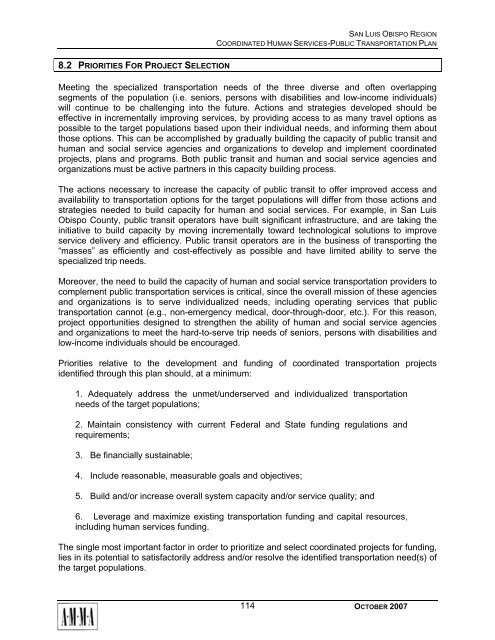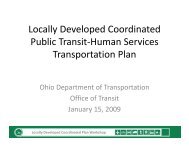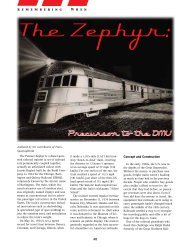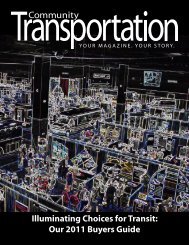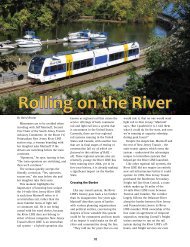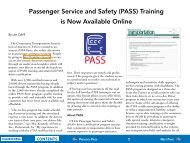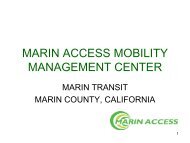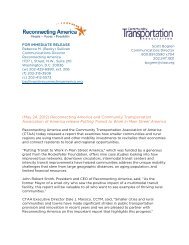San Luis Obispo - Caltrans - State of California
San Luis Obispo - Caltrans - State of California
San Luis Obispo - Caltrans - State of California
Create successful ePaper yourself
Turn your PDF publications into a flip-book with our unique Google optimized e-Paper software.
SAN LUIS OBISPO REGION<br />
COORDINATED HUMAN SERVICES-PUBLIC TRANSPORTATION PLAN<br />
8.2 PRIORITIES FOR PROJECT SELECTION<br />
Meeting the specialized transportation needs <strong>of</strong> the three diverse and <strong>of</strong>ten overlapping<br />
segments <strong>of</strong> the population (i.e. seniors, persons with disabilities and low-income individuals)<br />
will continue to be challenging into the future. Actions and strategies developed should be<br />
effective in incrementally improving services, by providing access to as many travel options as<br />
possible to the target populations based upon their individual needs, and informing them about<br />
those options. This can be accomplished by gradually building the capacity <strong>of</strong> public transit and<br />
human and social service agencies and organizations to develop and implement coordinated<br />
projects, plans and programs. Both public transit and human and social service agencies and<br />
organizations must be active partners in this capacity building process.<br />
The actions necessary to increase the capacity <strong>of</strong> public transit to <strong>of</strong>fer improved access and<br />
availability to transportation options for the target populations will differ from those actions and<br />
strategies needed to build capacity for human and social services. For example, in <strong>San</strong> <strong>Luis</strong><br />
<strong>Obispo</strong> County, public transit operators have built significant infrastructure, and are taking the<br />
initiative to build capacity by moving incrementally toward technological solutions to improve<br />
service delivery and efficiency. Public transit operators are in the business <strong>of</strong> transporting the<br />
“masses” as efficiently and cost-effectively as possible and have limited ability to serve the<br />
specialized trip needs.<br />
Moreover, the need to build the capacity <strong>of</strong> human and social service transportation providers to<br />
complement public transportation services is critical, since the overall mission <strong>of</strong> these agencies<br />
and organizations is to serve individualized needs, including operating services that public<br />
transportation cannot (e.g., non-emergency medical, door-through-door, etc.). For this reason,<br />
project opportunities designed to strengthen the ability <strong>of</strong> human and social service agencies<br />
and organizations to meet the hard-to-serve trip needs <strong>of</strong> seniors, persons with disabilities and<br />
low-income individuals should be encouraged.<br />
Priorities relative to the development and funding <strong>of</strong> coordinated transportation projects<br />
identified through this plan should, at a minimum:<br />
1. Adequately address the unmet/underserved and individualized transportation<br />
needs <strong>of</strong> the target populations;<br />
2. Maintain consistency with current Federal and <strong>State</strong> funding regulations and<br />
requirements;<br />
3. Be financially sustainable;<br />
4. Include reasonable, measurable goals and objectives;<br />
5. Build and/or increase overall system capacity and/or service quality; and<br />
6. Leverage and maximize existing transportation funding and capital resources,<br />
including human services funding.<br />
The single most important factor in order to prioritize and select coordinated projects for funding,<br />
lies in its potential to satisfactorily address and/or resolve the identified transportation need(s) <strong>of</strong><br />
the target populations.<br />
114<br />
OCTOBER 2007


